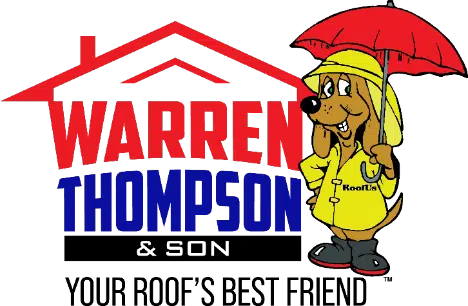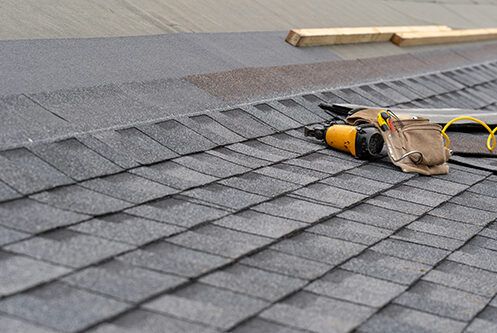There are many different components to residential and commercial roofing systems. While every component is important and serves a specific function, one of the most important is the roofing underlayment. In this article, we’ll explain what underlayment is, its role in a roofing system, and the differences between the various types.
Different Parts of a Roof System
A roof system consists of several parts that all work together to ensure the roof is structurally sound and leak-proof. The trusses or rafters inside the building support the roof. The roof deck or sheathing consists of sheets of plywood or OSB fastened to the trusses. The roof underlayment is then placed on top of the deck and secured. Finally, the shingles, tiles, metal roof panels, or other roofing materials are installed on top of the underlayment.
All roofs also have at least some metal flashing installed in places where the roof may be more prone to leaking. This includes around any vent pipes, chimneys, and other roof intrusions as well as in all valleys where two separate slopes meet.
How Underlayment Helps to Prevent Leaks and Damage
The roofing underlayment creates a watertight or waterproof barrier between the overlying roofing materials and the underlying roof deck. Although roofs are designed and built so that water easily drains off them, moisture can sometimes get under the shingles or whatever overlying roofing materials are used. This is especially true if the roofing materials are damaged or aren’t installed properly. It can also occur any time snow or ice sits on the roof and starts to melt.
Roofing underlayment ensures that moisture underneath the roofing materials can still drain away instead of soaking into the wooden sheets that make up the roof deck. This is important for preventing the roof deck from starting to warp, rot, crack or buckle. If the roof deck gets damaged, it can start to sag, be unsafe to walk on, or even collapse.
Without underlayment, a roof won’t last nearly as long as it could due to the damage that would result to the deck. Further, if you also have to replace the roof deck, replacing the roof will be more difficult and quite expensive. This is because the deck normally doesn’t need to be replaced unless it is damaged or not structurally sound.
A damaged roof deck also breaks the home’s seal, allowing conditioned air to escape and outside air in. Besides rising energy bills, you may notice extra drafts. Your home is also at risk for water leaks, resulting in extensive property damage and ruined belongings due to excess moisture and mold.
Types of Roof Underlayment
Three main types of roofing underlayments are commonly used nowadays, and each one has its pros and cons. As such, it’s important that you consider which one to use when replacing your roof. Our roofers can explain all your options and help you determine which is the best for your home.
Felt Underlayment
Felt underlayment has been around for much longer than the other types and is most commonly found on older roofs. Often referred to as felt paper or tar paper, this type of underlayment is made from either a paper or fiberglass mat that has been heavily saturated with asphalt to help make it water-resistant.
Felt underlayment is available in either No. 15 or No. 30 weight. No. 15 weight is cheaper, but it is also thinner and can tear quite easily. This is why most contractors recommend going with No. 30 felt if you use this type of underlayment.
The main advantage of felt underlayment is that it is relatively inexpensive compared to the other types, which makes it a good choice if you’re on a tight budget. The biggest drawback is that it is only water resistant and not fully waterproof like the other two underlayment options. Felt underlayment can work fairly well on roofs with a steep slope. However, it is not recommended for flat or low-slope roofs since water can seep into them and damage the roof deck. Another issue is that it tends to degrade over time and typically won’t last as long as the other options.
Self-Adhering Asphalt Underlayment
This type of underlayment is typically made from asphalt and rubber polymers. However, some manufacturers now use a range of other materials instead of asphalt. In any case, the underlayment is great for creating a waterproof membrane that will help lessen the chances of leaks compared to felt. While it can be used on sloped roofs, it is most commonly used for flat roofs or roofs with a much lower slope.
The back of the underlayment is sticky, which allows it to fully adhere to the roof deck without needing to use nails or staples. This is important since any nails or staples create points where water can seep through the underlayment into the roof deck. The fact that the underlayment is self-adhering also means that it is easier and takes less time to install. The underlayment also has a non-slip surface. This allows roofers to walk around on it more easily, which can also decrease the time it takes to install the new roof.
The main drawback to this type of underlayment is the cost, as it is usually the most expensive option. Another thing to consider is that it is meant to be permanently installed and can potentially damage the roof deck if it needs to be removed.
Synthetic Underlayment
Synthetic underlayment has quickly become the most popular option for sloped roofs in the past few decades. This type of underlayment is made of different synthetic polymers woven together to create an extremely durable, waterproof surface. Unlike felt, synthetic underlayment is also resistant to tearing, so you don’t have to worry about holes developing in it. It is also completely waterproof, fully resistant to mold growth, and lasts much longer.
While more expensive than felt, synthetic underlayment is a more cost-effective option than self-adhering underlayment. It is thinner and lighter in weight, and a single roll of a synthetic underlayment covers a much larger area than an asphalt underlayment. This can lessen the time it takes to install since the roofers won’t need to make as many trips up and down to carry additional rolls onto the roof. In most cases, synthetic underlayment is the best choice since it balances performance and price.
With more than 50 years of experience, Warren Thompson & Son Roofing & Siding is a company you can trust for all your roofing needs. We work with most residential and commercial roofing materials and on most types of roofs. Whether you need roof repairs or a roof replacement, you can count on us to get the work done promptly and ensure everything is done correctly. If you have any questions or need roof, gutter, or siding services in Alpha, NJ or the surrounding areas, contact Warren Thompson & Son Roofing & Siding today.

